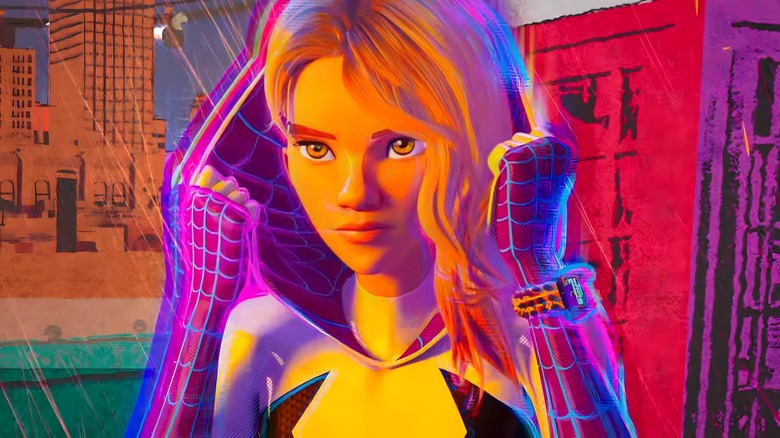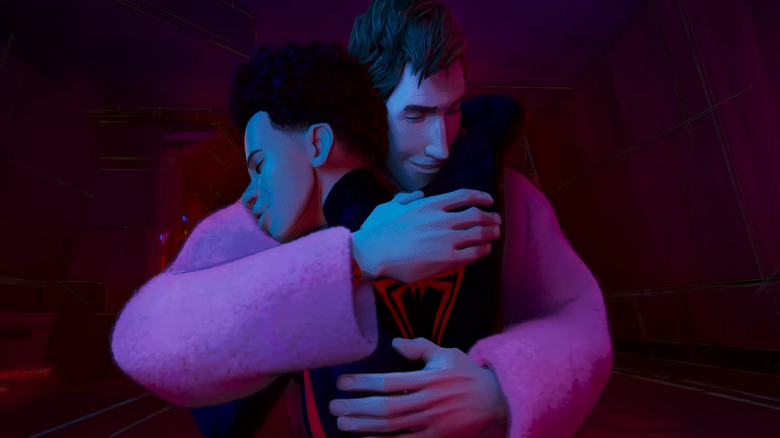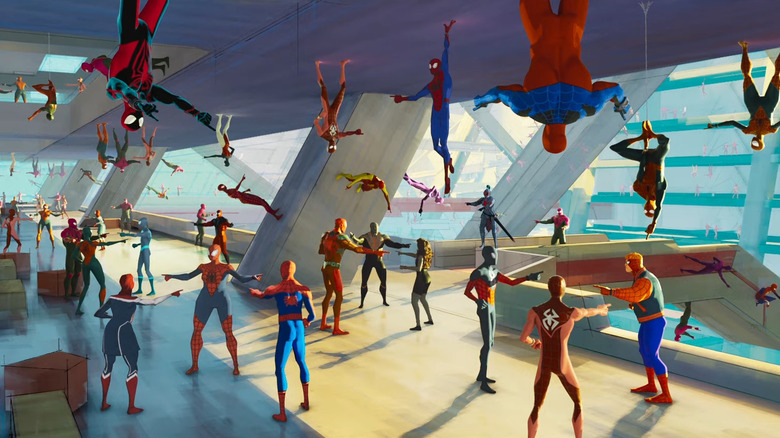How Does Across The Spider-Verse Set Up Beyond The Spider-Verse?
This article contains spoilers for "Spider-Man: Across the Spider-Verse"
Unlike its comparatively standalone predecessor, "Spider-Man: Across the Spider-Verse" is explicitly designed to lead into even bigger things. The movie does a whole bunch of heavy lifting to set up the full threat of the Spot (Jason Schwartzman) and the destiny-themed conflict between Miles Morales (Shameik Moore) and Miguel O'Hara's (Oscar Isaac) Spider-Society.
In fact, "Across the Spider-Verse" does such a good job at setting up the final installment of the trilogy that amidst the fireworks of the gorgeous animation, high-octane action, and emotionally impactful scenes, it can be easy to miss all the ways the movie quietly shuffles all the pieces of the plot to their correct places in order to jump-start "Spider-Man: Beyond the Spider-Verse" as efficiently as possible. Let's take a look at all the plotlines that "Across the Spider-Verse" sets up for the next installment in the franchise, and how they might play out.
The ending brings everything from the first two Spider-Verse movies together to tackle the third
"Spider-Man: Across the Spider-Verse" has two main plots to wrangle and expand on. The first one of them is the existence of the Spider-Society, a vast team of multiversal Spider-People who apparently devote their lives to protecting the Spider-Verse canon ... and therefore, the multiverse. The second one is the arrival of the Spot, a likewise multiversal villain who grows from a mild, comedic nuisance to a potentially all-encompassing threat within the course of the movie, dramatically altering both his appearance and attitude in the process.
The end of "Across the Spider-Verse" establishes that the Spot has now reached a completely unprecedented power level, and presents a threat that's both personal to Miles and, if his powers and universe-hopping tendencies are anything to go by, very possibly omniversal. Meanwhile, the Spider-Society remains determined to stop Miles from interfering with his father's (Brian Tyree Henry) impeding murder, and a Spidey task force has entered Earth-1610 to accomplish their mission ... incidentally putting them on the Spot's path in the process. While it seems clear that Miguel has no intention of interfering with the villain's immediate plans, the Spot still presents a massive threat, and the conflict between him and the Spider-Society seems imminent in "Beyond the Spider-Verse."
Meanwhile, "Across the Spider-Verse" marks the return of several "Into the Spider-Verse" heroes, most prominently Gwen (Hailee Steinfeld) and Peter B. Parker (Jake Johnson). While the two end the movie in less than ideal terms with Miles after the latter finds out Spider-Society's true intents, Spider-Punk's (Daniel Kaluuya) DIY universe-traversing machine allows them to gather the "Into the Spider-Verse" squad and a few other players who are friendly to Miles, which brings yet another Spidey faction in the mix.
The Earth-42 storyline teases important new plot elements for Beyond the Spider-Verse
The end of "Across the Spider-Verse" seems to tease a "Captain America: Civil War"-style conflict between pro- and anti-Miles Spidey factions, as Miguel and Gwen have gathered their respective forces to either stop or help Miles in saving his father. Of course, everyone involved is still a hero, so a less ambitious movie series would just have them battle for a while before teaming up against the Spot.
The introduction of Earth-42 — the home dimension of the spider that bit Miles — in the mix throws all conventional attitudes out of the window, though. Before this, we've only dealt with alternate-universe Spider-People and the occasional reimagined villain. Here, we get a glimpse of an entire alternate non-Spidey version of Miles, who lives in a dystopic world and operates as the Prowler under Uncle Aaron's (Mahershala Ali) tutelage.
Alternate versions of Peter Parker aside, this is the second time the movie brings in an entirely different version of the exact same Spider-adjacent character. Miguel's tragic backstory also involves an ill-fated alternate-universe counterpart, whose place he attempted to take with dramatic and world-destroying results. It remains to be seen how far "Beyond the Spider-Verse" will take this new concept, but since "Across the Spider-Verse" essentially establishes that different Spider-People can bump into alternate versions of themselves, too, the third movie could just add an extra dimension to its game by having not just a glut of alternate-reality Spider-People face off ... but bringing in all sorts of alternate-universe identities of the individual spider-folks, as well.
If "Beyond the Spider-Verse" intends to use even a fraction of the opportunities "Across the Spider-Verse" sets up, fans may very well get to witness the biggest, boldest Spider-Man movie yet on March 29, 2024.


